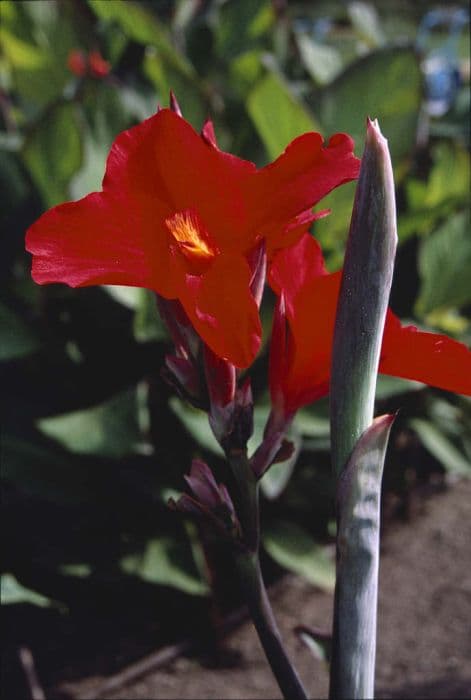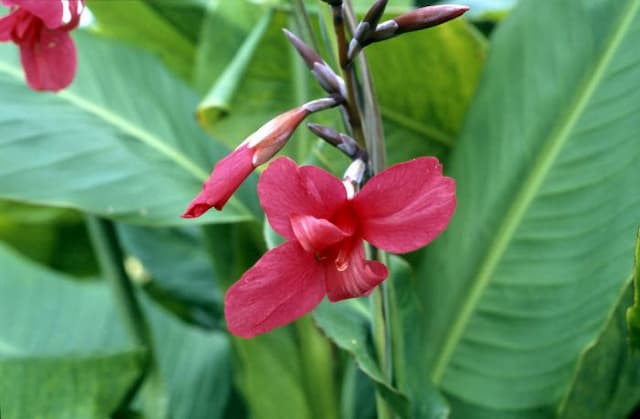Canna Lily Canna 'Cleopatra'

ABOUT
Canna 'Cleopatra' is a strikingly ornamental plant known for its unique and vibrant appearance. The plant boasts large, broad leaves that are an exotic blend of green and bronze, some with streaks and patches of contrasting colors. The foliage alone makes a bold statement in the garden with its lush and tropical look. The real showstopper is the flowers that emerge from this plant, which display a mesmerizing mix of yellow and red. The flowers are large and flamboyant with an irregular distribution of colors. Some blooms might be predominantly yellow with random flecks and streaks of red, while others could be mostly red with splashes of yellow. The petals have a classic shape that is somewhat reminiscent of gladiolus and iris flowers, giving them a distinctly elegant and sculptural quality. The blossoms grow atop tall stalks that rise from the plant's foliage, creating a visually stunning canopy of color when viewed from a distance. Canna 'Cleopatra' has a lush and tropical aura, making it a focal point in any garden setting where it adds a touch of drama and exuberance.
About this plant
 Names
NamesFamily
Cannaceae.
Synonyms
Canna Lily, Cleopatra Canna, Variegated Canna.
Common names
Canna 'Cleopatra'
 Toxicity
ToxicityTo humans
The Canna 'Cleopatra', commonly known as Canna or Canna Lily, is not considered highly toxic to humans. However, as with many plants, it may cause mild stomach upset if ingested in large quantities. Some people may also have a skin reaction if they are allergic or particularly sensitive to the plant.
To pets
The Canna or Canna Lily is similarly not considered highly toxic to pets. If a pet consumes part of this plant, it may experience mild gastrointestinal upset, such as vomiting or diarrhea, but severe poisoning is unlikely. As with humans, certain pets might have an allergic reaction, so it is wise to monitor them and contact a veterinarian if you observe any unusual symptoms after ingestion.
 Characteristics
CharacteristicsLife cycle
Perennials
Foliage type
Deciduous
Color of leaves
Variegated
Flower color
Mixed
Height
4-6 feet (1.2-1.8 meters)
Spread
1.5-2 feet (0.45-0.6 meters)
Plant type
Herb
Hardiness zones
7-10
Native area
South America
Benefits
 General Benefits
General Benefits- Visual Interest: Canna 'Cleopatra' adds a bold visual statement to gardens with its striking variegated foliage and vibrant red and yellow flowers.
- Easy to Grow: It is known for being relatively easy to cultivate, adapting to a variety of soil types and requiring minimal maintenance.
- Drought Tolerant: Once established, Canna 'Cleopatra' has a good tolerance for drought, making it a suitable choice for water-wise gardens.
- Fast Growth: It has a rapid growth rate, quickly filling in garden spaces and providing lush foliage and blooms.
- Pest Resistance: Canna 'Cleopatra' is resistant to many common garden pests, reducing the need for chemical interventions.
- Attracts Pollinators: The bright flowers are attractive to pollinators like bees, butterflies, and hummingbirds, promoting biodiversity.
- Architectural Structure: Its tall, robust form provides architectural interest and can be used as a focal point or to add height to planting schemes.
- Versatile Usage: This plant can be used in a variety of garden settings, including borders, containers, and as a background plant.
- Seasonal Interest: It offers vibrant seasonal interest from late spring to the first frost with its attractive foliage and flowers.
- Easy Propagation: Canna 'Cleopatra' can be easily propagated by dividing rhizomes, allowing gardeners to expand their display or share with others.
 Medical Properties
Medical PropertiesThis plant is not used for medical purposes.
 Air-purifying Qualities
Air-purifying QualitiesThis plant is not specifically known for air purifying qualities.
 Other Uses
Other Uses- Bioplastic Production: Canna 'Cleopatra' starch can be extracted and used in the production of biodegradable plastics, offering an eco-friendly alternative to traditional plastics.
- Paper Making: The fibers from Canna 'Cleopatra' can be used in the handmade paper industry, giving the paper a unique texture and strength.
- Natural Dye: The flowers and leaves of Canna 'Cleopatra' can produce natural dyes for fabrics, allowing for a sustainable way of textile coloring.
- Floral Arrangements: Canna 'Cleopatra' adds a tropical, dramatic flair to floral arrangements and can be used for their long-lasting cut flowers.
- Pond Filtration: They can be planted around ponds where their root systems help filter water and keep the aquatic environment clean.
- Soil Erosion Control: Due to their extensive root system, Canna 'Cleopatra' can be used to stabilize soil and prevent erosion along riverbanks and slopes.
- Craft Material: Dried stems of Canna 'Cleopatra' can be used as a natural material for crafting, such as in basket weaving or as structural elements in floral crafts.
- Edible Shoots: Young shoots of Canna 'Cleopatra' are sometimes consumed as a vegetable in some cultures, often cooked similarly to asparagus.
- Animal Feed: The foliage and leftovers of Canna 'Cleopatra' can be used as fodder for livestock like pigs and cows.
- Photography Backdrops: Canna 'Cleopatra', with its striking foliage and blooms, is often used as a captivating natural backdrop for garden and nature photography.
Interesting Facts
 Feng Shui
Feng ShuiThe Canna is not used in Feng Shui practice.
 Zodiac Sign Compitability
Zodiac Sign CompitabilityThe Canna is not used in astrology practice.
 Plant Symbolism
Plant Symbolism- Regality and splendor: Named after the Egyptian queen Cleopatra, known for her beauty and power, the Canna 'Cleopatra' symbolizes the opulence and grandeur of royalty.
- Transformation and change: The Canna 'Cleopatra' often exhibits a unique characteristic where a single plant has leaves and flowers with different colors and patterns, representing the idea of change and adaptability in life.
- Confidence and presence: With its bold colors and large leaves, the Canna 'Cleopatra' stands out in any garden, symbolizing a strong presence and the confidence to be seen and noticed.
- Fertility and creativity: As a prolific bloomer and a plant that can be easily hybridized, the Canna 'Cleopatra' symbolizes fertility and the creation of new ideas.
- Vibrancy and energy: Cannas in general are known for their vibrant flowers and lush foliage, which represent a zest for life and enthusiasm.
 Water
WaterCannas, including the 'Cleopatra', should be watered deeply to ensure the soil is moist but not waterlogged, typically requiring about 1 to 2 inches of water each week. During hot periods or if you're growing them in containers, they may need watering more frequently to prevent the soil from drying out, possibly every other day. It's essential to allow the top inch of soil to dry out slightly before rewatering to encourage healthy root growth. When you do water, aim to apply the water directly to the soil, avoiding wetting the foliage to prevent fungal diseases. A general rule of thumb is to provide your Canna 'Cleopatra' with around one gallon of water per square foot every week during the growing season.
 Light
LightCanna 'Cleopatra' thrives in full sun where it can receive at least six to eight hours of direct sunlight per day. Placing it in a spot that receives morning sunlight and some afternoon shade can help protect it in areas with extremely hot summers. If grown indoors, a south-facing window can be ideal to provide it with the bright light it needs to flourish.
 Temperature
TemperatureCannas like the 'Cleopatra' prefer warm temperatures and are frost-sensitive. They can typically survive in temperatures as low as 50 degrees Fahrenheit but grow best when temperatures are between 70 and 90 degrees Fahrenheit. It's crucial to protect them from frost, as temperatures below 50 degrees Fahrenheit can cause damage or even kill the plant.
 Pruning
PruningPrune your Canna 'Cleopatra' to remove old flowers and seed pods to encourage further blooming and to prevent the plant from becoming leggy. After the first frost in autumn, cut back the foliage to a few inches above the ground to prepare the plant for winter. Pruning can be done throughout the growing season as needed to maintain a tidy appearance.
 Cleaning
CleaningAs needed
 Soil
SoilThe best soil mix for Canna Lily 'Cleopatra' is a rich, well-draining soil with a mix of loam, compost, and perlite or sand to ensure adequate drainage. The soil pH should ideally be between 6.0 and 6.5. This plant appreciates fertile ground, so consider adding a slow-release fertilizer at the beginning of the growing season.
 Repotting
RepottingCanna Lily 'Cleopatra' should be repotted every 2 to 3 years or when you notice that the plant has outgrown its current container. Repotting is best done in the spring before the new growth starts.
 Humidity & Misting
Humidity & MistingCanna Lily 'Cleopatra' thrives in average to high humidity levels. Providing a humidity level of around 40-60% will create an ideal environment for this plant. They are tolerant of outdoor humidity levels and typically do not require additional humidity when grown indoors if kept in normal room conditions.
 Suitable locations
Suitable locationsIndoor
Provide Canna Lily 'Cleopatra' with bright light and periodic feeding.
Outdoor
Plant Canna Lily 'Cleopatra' in full sun and water regularly.
Hardiness zone
8-11 USDA
 Life cycle
Life cycleThe life of the Canna 'Cleopatra', also known as Canna Lily, begins as a rhizome which, when planted in spring after the last frost, will sprout and develop into a sturdy stem. Leaves emerge from the stem, characterized by their broad, paddle-like shape and often with streaks of color varying from green to maroon. By mid-summer, the Canna Lily reaches its flowering stage, displaying a mix of red and yellow blooms that can exhibit a striking, spotted or streaked pattern due to its unique genetic makeup. After the flowering period, which can last until the first frost, the plant sets seed in the form of capsules that can be harvested if desired. With the arrival of cool autumn weather, the plant's above-ground foliage will die back, and the rhizome will enter a dormant period during winter. In climates where frost occurs, the rhizome must be lifted and stored until it is replanted the following spring, thus repeating the cycle.
 Propogation
PropogationPropogation time
Spring to Summer
The Canna 'Cleopatra', commonly known as Canna Lily, can generally be propagated by dividing the rhizomes. This is best done in spring as new growth begins. The process involves carefully digging up the plant and separating the rhizomes with a sharp knife, ensuring that each section has at least one eye or bud. The cut rhizome pieces, typically about 3 to 5 inches long (7.6 to 12.7 centimeters), are then planted in well-draining soil at a depth of 3 to 4 inches (7.6 to 10.2 centimeters). Rhizome division is a quick and effective way to propagate Canna Lilies, helping to maintain the unique characteristics of 'Cleopatra', especially its distinctive variegated foliage and multi-colored blooms.









